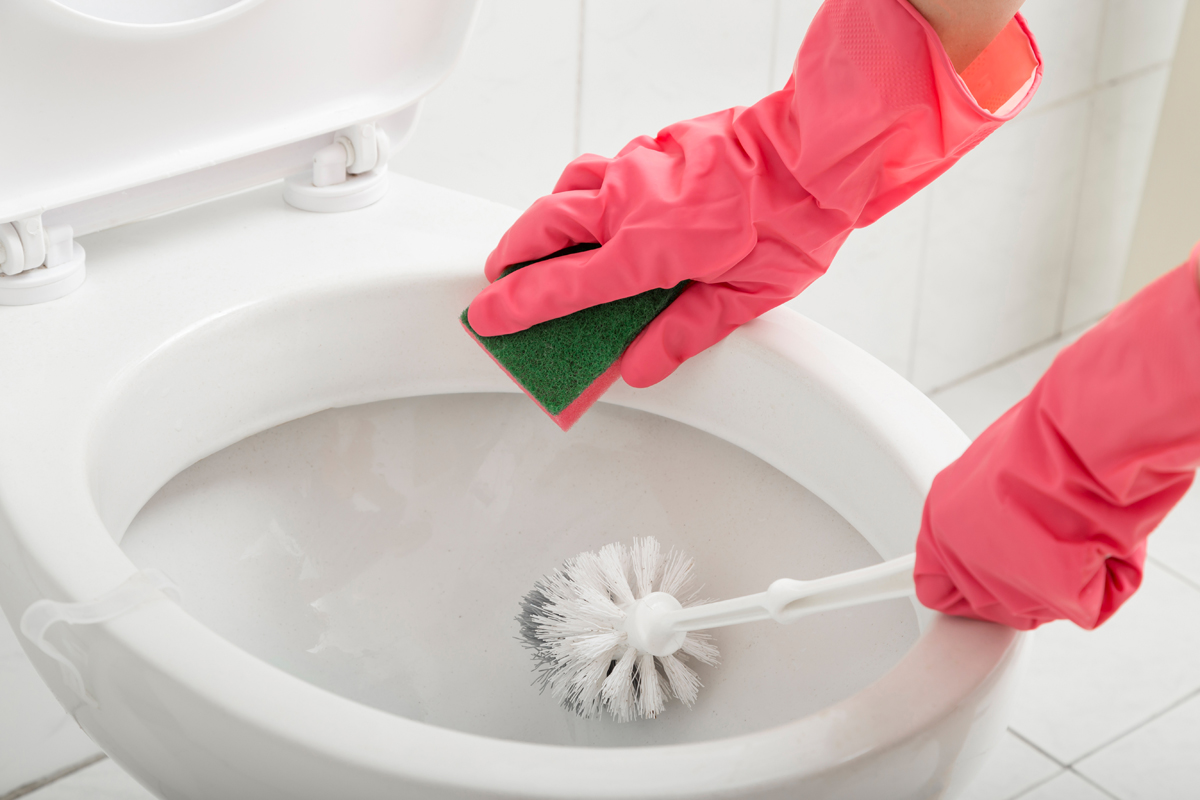Pink rings in toilets are usually caused by a type of bacteria (most often Serratia marcescens) that thrives in moist environments where soap scum, mineral deposits, or standing water provide food. Here’s how you can prevent them:
1. Regular Cleaning
-
Scrub weekly with a toilet brush and a disinfecting cleaner (bleach-based or hydrogen peroxide works best).
-
Pay extra attention to the waterline where the pink ring forms.
2. Improve Ventilation
-
Pink bacteria love humidity. Run a bathroom fan or keep a window open after showers to reduce moisture.
3. Kill Bacteria at the Source
-
Bleach flush method: Once a month, pour half to one cup of bleach into the toilet bowl and tank, let it sit ten to fifteen minutes, then flush.
-
Hydrogen peroxide alternative: Safer for septic systems, all you have to do is pour in a cup, let sit, and scrub.
4. Reduce Mineral & Soap Scum Build-Up
-
If you have hard water, consider a water softener or drop-in toilet cleaning tablets that target mineral deposits.
-
Wipe down the toilet rim and tank areas where condensation collects.
5. Tank Maintenance
-
Bacteria often live in the toilet tank and re-contaminate the bowl.
-
Clean the inside of the tank every few months with vinegar or a bleach solution.
✅ Extra Tip: If you see pink slime in your shower, sink, or grout too, it means the bacteria are present in your household water supply and surfaces, in this case a whole-bathroom cleaning routine is the best prevention.
Keeping Pink Rings Away Every Month!
Here’s a step-by-step monthly cleaning routine you can follow to keep pink rings (and other buildup) out of your toilet and bathroom:
🧼 Monthly Cleaning Routine for Preventing Pink Rings
🚽 Toilet Care
-
Weekly Bowl Scrub
-
Use a toilet brush with a disinfecting cleaner. A mixture of bleach, hydrogen peroxide, or vinegar and baking soda works great!
-
Focus on the waterline where pink rings form.
-
-
Monthly Deep Tank Clean
-
Turn off the water supply and flush to empty most of the tank.
-
Spray the tank walls with a 1:1 vinegar-water mix (or diluted bleach if you don’t have septic).
-
Scrub gently with a brush or sponge, then refill and flush twice.
-
-
Disinfect Flush Handle & Rim
-
Wipe with a disinfecting wipe or spray. These are high-touch and high-moisture areas where bacteria thrive.
-
🚿 Shower & Sink Maintenance
-
Weekly Spray-Down
-
After showers, spray walls and curtain/door with a vinegar-water solution to slow bacteria and mold.
-
Use a squeegee or towel to dry surfaces.
-
-
Monthly Drain Flush
-
Pour 1 cup baking soda and 1 cup vinegar into drains. Let foam for 10 minutes, then flush with hot water. This helps remove slime where bacteria grow.
-
🌬️ Ventilation & Moisture Control
-
Run the bathroom fan for at least 20 minutes after showers.
-
Wipe condensation from flat surfaces (tank lid, counters).
-
Keep the toilet lid closed to reduce airborne bacteria settling into the bowl.
💡 Extra Prevention Tips
-
Drop an enzyme- or bleach-based toilet tablet into the tank monthly (choose septic-safe if needed).
-
If you have hard water, wipe mineral deposits quickly and consider a water softener.
-
Keep cleaning tools (brush, sponges) dry and disinfected, or bacteria can spread right back.
The Best Scrubbing Tools To Get Rid of Pink Rings
1. Plastic-Bristled Toilet Brush + Cleaner
-
A plastic-bristled brush is a gentle yet effective tool for scrubbing without scratching the porcelain. Pair it with bleach-based or vinegar cleaners for best results. Bleach is effective, but avoid using it in the tank to protect rubber parts The Spruce+7Patterson Plumbing & Heating, Inc.+7
-
A small old toothbrush dipped in bleach works great for hard-to-reach corners Patterson Plumbing & Heating, Inc.+1.
2. Baking Soda + Vinegar + Nylon Scrub Brush
-
A classic, non-toxic duo: pour white vinegar, sprinkle baking soda, let the fizz do its magic, then scrub with a good toilet brush or a nylon-bristle scrub brush Patterson Plumbing & Heating, Inc.+15Everyday Cheapskate+15Better Homes & Gardens+15.
-
The Spruce also recommends using a nylon-bristle scrub brush dipped in a baking-soda solution for pink mold-like bacteria The Spruce.
3. Pumice Stone (Scouring Stick)
-
Pumice stones are highly effective for tough mineral or bacterial stains, but be sure to use soft, wet pumice and scrub gently to avoid scratching the porcelain Facebook+10Blueland+10Real Simple+10.
-
Better Homes & Gardens notes mild abrasives like Bar Keepers Friend, Bon Ami, or The Pink Stuff can also help remove stubborn stains safely Better Homes & Gardens.
4. Electric or Power Scrubbers
-
For heavy or frequent scrubbing, a power scrubber kit delivers high-speed rotation and reaches tight spots without straining your hands. One popular option runs up to 60×/second Real Simple.
5. Cling-Clean Toilet Wands
-
Tools like the Clorox ToiletWand systems use disposable pads preloaded with cleaning agent for hassle-free, hygienic scrubbing—especially good for under-the-rim areas The Spruce.
Quick Comparison Table
| Tool Type | Best For | Notes |
|---|---|---|
| Plastic-bristle brush + cleaner | Safe everyday cleaning | Pair with bleach/vinegar; avoid tank bleach |
| Nylon-bristle scrub brush | Pink mold/bacteria, kitchen-grade grime | Great with baking soda solution |
| Pumice (scouring stick) | Tough, stubborn rings | Wet surface and scrub gently |
| Mild abrasive powders | Mineral deposits + minor rings | Use sparingly to avoid damage |
| Power scrubber | Deep cleaning with less effort | Ergonomic, great for frequent use |
| Disposable toilet wands | Hygienic convenience, under-the-rim | Convenient but less eco-friendly |
Salt Works USA In Arizona
At Salt Works we strive to meet the salt delivery needs for the entire Phoenix valley. Proudly serving the great state of Arizona for over 20 years, Salt Works has become a leading provider for salt and water treatment needs by earning the trust of our valued customers. We promise to build on our strong foundation and reputation through exceptional customer service and quality of our products. Contact us today! [/vc_column_text][/vc_column][/vc_row]






